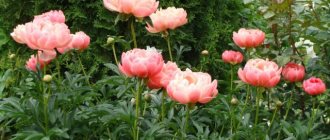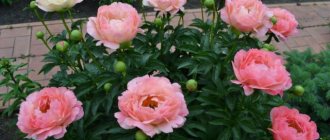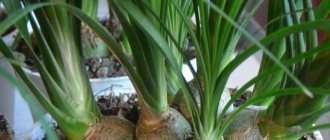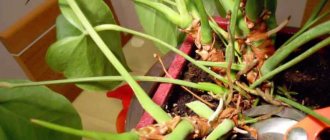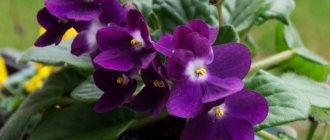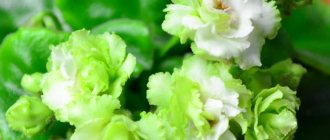Peonies fascinate with their beauty in early May. In plots, gardens, and city flower beds, red, coral, burgundy, pink, and white peonies delight passersby. A heady aroma fills the spring air. The coral sunset peony is a real decoration for any garden; it lifts the mood with its unusual color of soft peach or dark coral.
Interesting! The milky-flowered peony becomes a bright coral color after the bud is fully opened.
Characteristics and description of the variety with photos
Coral Sunset was bred in 1965 by the joint efforts of breeders S. Wissing (USA) and L. Cousins (Canada). Thanks to its spectacular buds and sophisticated aroma, coral peony has rapidly gained popularity among flower growers in America and Europe. In Russia, it is grown in the south, in the middle zone and some northern regions. The main requirement is that the summer average daily temperature does not fall below 10*C.
Being a hybrid, Coral Sunset successfully combines the features of herbaceous and tree peonies. The plant is a tall, leafy bush with large buds and strong stems.
Hive parameters:
- height – 90-110 cm;
- crown volume – 80-90 cm;
- bud diameter – 15-20 cm.
The hallmark of the hybrid is fragrant semi-double buds with petals arranged in 5-7 rows. In the first days of flowering, the petals are painted in pastel colors with a slight admixture of pink, but after the bud fully opens, they acquire an expressive coral hue. Regardless of the growth stage, the core is always lighter than the tips. The petals are curved inside the bud and partially cover the core of the flower.
Peculiarity! Lush flowering of peony is observed only from the third year of life. It begins in the first days of June and continues until mid-July.
Reviews from gardeners
Evgeniya: We planted Sunset and Supreme varieties. I liked the second one better - it doesn’t have such an acidic orange color, but is much more pleasing to the eye. In addition, there is less burnout. In addition, the bush of the Supreme variety looks slender, and Sunset is constantly falling apart. Lisa: My favorite peony is Coral Sunset. He is the most beautiful! No other variety has such a graceful transition from thick coral to greenish-white. It is simply mesmerizing! Alexandra: I ordered Hawaiian Coral, and it pleasantly surprised me. The only one from the coral series that bloomed in the first year. True, the buds had to be cut off - strictly according to technology. We are waiting for indescribable beauty for 2-3 years!
How to grow Coral Sunset peony?
Coral peonies are unpretentious and frost-resistant plants. With proper care, they do not cause trouble to the gardener and hardly get sick.
But you can achieve bright and lush flowering only if you follow the basic principles of cultivation:
- choosing a suitable place on light soil;
- timely watering and balanced fertilizing;
- high-quality preparation for wintering.
Landing location
Coral Sunset loves sun and space. Therefore, the landing site must satisfy the following criteria:
- Solarization. The area should be well lit for most of the day (at least 12 hours). Shading negatively affects the quality of peony flowering.
- Wind protection. The location must be protected from gusty squalls. Planting is allowed near buildings and hedges located on the windy side. In this case, the distance to the nearest building must be at least 2 meters.
- Distance from trees and bushes. Peony has a well-branched root system. For normal growing season, an appropriate distance must be maintained to the nearest competitive plants.
- No spring flooding. If there is water on the flowerbed during March-April, the flowers will begin to suffer from root rot.
Soil requirements
Peony prefers light soil - ideally loam or sandy loam. If the soil on the site is heavy, then the top layer of soil will have to be replaced before planting.
To do this, remove the top 50 cm of soil and fill the resulting depression with a specially prepared soil mixture:
- 2 parts of turf;
- 2 parts vermicompost;
- 1 part sand.
The soil should be slightly acidic or neutral. Optimal pH level = 6.5.
Attention! The acidity of the soil is reduced with the help of lime fertilizers, and increased by the application of manure and vermicompost.
When to plant a plant?
Coral Sunset is planted in spring or early fall. After spring planting, a young and weak plant goes through a sweltering period of summer heat, which is why it often gets sick and develops poorly. Therefore, planting in September is considered preferable.
The landing is carried out according to the following scheme:
- Dig planting holes about 50 cm deep at intervals of about 1 meter. If the flowerbed is located near groundwater, deepen the hole to 70 cm and fill the bottom with a mixture of sand and gravel.
- The root collar is positioned so that the upper bud does not reach the edge of the hole by 5 cm.
- The roots of the plant are sprinkled with sifted soil and compacted to eliminate air pockets.
- A border 5 cm high is formed around the planted peony, after which the seedling is watered abundantly.
Varieties
Thanks to the successful and painstaking work of many breeders, a large number of varieties of this plant have been developed.
"Coral Pink"
This beautiful plant reaches 75 centimeters in height, has soft green carved leaves, as well as double flowers of a light pink hue. When opened, the bud reaches 13 centimeters in circumference. Flowering begins in June and lasts about 3 weeks. This variety is very popular among gardeners due to its beauty and compactness.
"Pink Hawaiian Coral"
This variety of peonies was bred in the 90s of the last century by American scientists. It is a perennial herbaceous plant that grows up to one meter in height. At the same time, its stems are quite dense and dotted with green carved foliage. The flowers are semi-double and large, up to 21 centimeters in diameter, with an apricot tint. Very often they are used for cutting.
Flowering begins early - in April, and lasts up to 3 weeks (maybe longer in cool weather).
"Pink Hawaiian Coral" tolerates cold well and does not require additional shelter during the frost period.
"Coral Beach"
Peony is distinguished not only by its beautiful and lush bush up to one meter in height, but also by its delicate coral color. The flower itself is small, up to 15 centimeters in diameter. The inflorescences are semi-double, with a yellow center. In their shape, the open buds are somewhat reminiscent of lotus flowers. A distinctive feature of peonies of this variety is their resistance to various temperature changes, as well as to some fungal diseases. Thanks to this, it is very popular among many summer residents.
"Fairy Coral"
This variety of peonies is an interspecific hybrid. Its appearance dates back to the last century. The bush is low, up to 70 centimeters, the stems are dense with beautiful decorative leaves. Coral semi-double buds, when opened, reach up to 15 centimeters in diameter and emit a delicate aroma.
Flowering is very early and long. In addition, this plant is not afraid of even severe frosts and tolerates drought well.
"Coral Sunset"
A very popular variety of peonies. It is compact, but the height of the plant reaches in some cases up to one meter. Semi-double buds are located on tall, erect stems, which are pink-peach in color with a hint of red coral. The leaves are green in color. Flowering begins early. "Coral Sunset" has received many awards at various exhibitions not only due to its beauty, but also for its easy care and resistance to temperature changes.
"Coral Magic"
This newly developed peony variety has wowed everyone with its colorful flowers. These are semi-double three-row buds with a very bright color that are visible from afar. They reach up to 15 centimeters in circumference and have yellow stamens in the middle. The bush is compact and low, up to 70 centimeters. The stems are erect with delicate green foliage. Flowering begins in April.
"Coral Supreme"
This hybrid plant is very rare. The bush has powerful stems that grow up to one meter in height. Its carved bright green leaves cover almost the entire bush, only the coral-salmon buds located at its very top are visible. When they open, they look like a bowl reaching up to 19 centimeters in diameter. In addition, during flowering they emit a very subtle aroma.
It begins in late April - early May and lasts up to two weeks.
"Coral and Gold"
This peony variety amazes everyone with its unusual beauty and large flowers. Already at the end of March or beginning of April, you can see double coral buds on the tops of a huge bush, up to 95 centimeters tall. When they bloom, they can be up to 21 centimeters in diameter. In addition, the flowers exude a rich, sweet aroma. The stems are decorated with green carved leaves.
"Topeka Coral"
Peonies of this variety are distinguished by double bomb-shaped buds. At the beginning of flowering, their color is pink-red, but as they open, the flowers become coral. The Topeka Coral bush does not grow higher than 65 centimeters. The leaves are carved with a dark green color.
"Coral Charm"
This variety of semi-double peonies is very popular among gardeners, so it is most often purchased for planting in personal plots. Its color is very unusual: a dark pink flower, which as it blooms becomes coral with a delicate white border. At the very end of flowering it turns yellow. The bud itself is large, up to 22 centimeters in size, and consists of eight rows of petals.
The stems are straight and strong, with a reddish color. Peony leaves are green and carved. The height of the bush reaches a meter in height. Flowering begins in early June.
Flower care: basic rules
Care is performed according to the following rules:
- The top layer of soil around the plant should always remain loose. This is necessary to maintain air exchange in the soil. Loosening is carried out in the interval between waterings, preventing the formation of a hard earthen crust.
- To speed up the growing season, growth stimulants should be used: Epin, Zircon, Kornevin. The preparations are diluted in water according to the instructions and applied after watering.
- At the end of flowering, it is advisable to apply phosphorus fertilizers to replenish the resulting deficiency.
- Until the age of 3, it is necessary to stimulate the growth of the root system, limiting flowering. To do this, during the formation of the ovaries, all the buds are pinched off. If the buds are left, the peony will not produce maximum flowering at maturity.
Preparing for winter
Coral Sunset is a winter-hardy hybrid. It tolerates frost well in the presence of snow cover. For successful wintering, plants carry out preparatory measures:
- Feed plants with phosphorus after flowering.
- Mulch the flowerbed in the autumn.
- Carry out autumn pruning.
Attention! In severe frosts (below -10*C), peonies should be covered with burlap, creating a kind of protective hut.
Is mulching necessary?
In the fall, after the plant enters the dormant phase, the flowerbed is mulched. The following is used as mulch:
- crushed straw;
- sawdust;
- pine needles;
- dried grass.
A 15 cm layer of mulch prevents deep freezing of the soil in winter. In early spring, the mulch is removed so that it does not interfere with the hatching of young shoots.
Bush pruning
Timely pruning significantly increases the plant’s chances of successful wintering. The entire above-ground part of the bush must be removed, excluding growth shoots above the buds, the length of which does not exceed 5 cm. All stems are shortened to “stumps” 5-10 cm long. Pruning at the root is strictly not recommended - this can injure the root system.
Other trimming features:
- early pruning can disrupt the process of photosynthesis and weaken the plant;
- the optimal time for pruning is late autumn with consistently cold weather (in the middle zone this period occurs in the first half of November, in northern latitudes - the end of October);
- the condition of the plant (the presence of diseases or pest attacks) should not affect the timing of pruning.
Peony propagation Sunset coral
Peony is propagated in one of three ways:
- Seeds. Used only for breeding purposes.
- Dividing the bush. The simplest method. A bush 3-4 years old is dug up, cleared of soil, washed with water and lowered into the cellar for 3-6 hours. This is necessary to soften the roots. Then, using a knife, the bush is divided into seedlings with buds and lateral shoots. The cut areas are treated with garden varnish.
- By layering. A formwork in the form of a box is installed around the buds of an adult bush and filled with compost. In autumn, the formwork is removed and the seedlings are transferred to a new location.
History of appearance
Coral sunset embodies a successful combination of tree and herbaceous varieties. Two breeders did a lot for its appearance: the American Samuel Wissing and the Canadian Lyman Cousins. But much of the credit for this work still belongs to the first scientist, since he is the direct author of Coral Sunset. He spent 26 years creating a noble culture. The world learned about the peony variety, whose name is translated from English as “coral sunset”, in 1965, and the popularity of the flower has not decreased to this day - both among professionals and among novice flower growers. Over the years, this crop has participated in various competitions, where it received high awards and titles not only for its magnificent appearance, but also for its unpretentiousness and resistance to cold weather.
Diseases and pests
Coral Sunset peonies have strong immunity and get sick only if the rules of agricultural technology are not followed. Flower diseases can affect:
- gray rot;
- powdery mildew;
- ring mosaic;
- leaf deformation.
Of the pests, peonies are most often attacked by nematodes, green bronze and kuzka. To prevent diseases and timely eliminate pests, it is recommended to regularly inspect the above-ground parts of the bushes. Periodic treatments with Fitosporin will help to avoid fungal diseases. Insecticidal preparations are used to control pests.
Rate this post
Use Cases
A noble plant will favorably emphasize the beauty of a flower bed or garden plot if you place it in group compositions with other peonies or other flowering perennials that have the same shoot height as our hero. The variety is appropriate in mixborders, in ensembles with decorative foliage crops. It can also be planted as a single bush. Coral sunset goes well with low-growing conifers and evergreens, as well as roses and clematis. Shoots with coral flowers make delightful bouquets.
